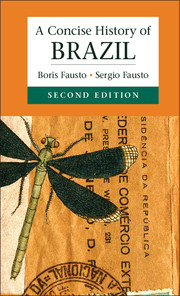Book contents
- Frontmatter
- Dedication
- Contents
- List of Maps
- Preface
- Map
- 1 Colonial Brazil (1500–1822)
- 2 Imperial Brazil (1822–1889)
- 3 The First Republic (1889–1930)
- 4 The Vargas State (1930–1945)
- 5 The Democratic Experiment (1945–1964)
- 6 The Military Government and the Transition to Democracy (1964–1984)
- 7 Modernization under Democracy (1985–2010)*
- Bibliography
- Index
5 - The Democratic Experiment (1945–1964)
Published online by Cambridge University Press: 05 August 2014
- Frontmatter
- Dedication
- Contents
- List of Maps
- Preface
- Map
- 1 Colonial Brazil (1500–1822)
- 2 Imperial Brazil (1822–1889)
- 3 The First Republic (1889–1930)
- 4 The Vargas State (1930–1945)
- 5 The Democratic Experiment (1945–1964)
- 6 The Military Government and the Transition to Democracy (1964–1984)
- 7 Modernization under Democracy (1985–2010)*
- Bibliography
- Index
Summary
The Elections and the New Constitution
After Vargas’s fall, the armed forces and the liberal opposition, in agreement with the two presidential candidates, decided to turn power over, temporarily, to the Federal Supreme Court. The timetable setting elections for 2 December was maintained.
Judging by the size of crowds at rallies, it seemed that Brigadier Eduardo Gomes’s candidacy was forging ahead, while Dutra’s was marking time. Gomes’s campaign rallied sectors of the urban middle class in the larger cities. They united under the banner of democracy and economic liberalism. Dutra excited no one, and people went so far as to propose replacing him with a candidate with greater electoral appeal. Almost on the eve of the election, Vargas finally came out in favor of Dutra. Even so, he added that he would be on the side of the people against the president if the president did not fulfill his campaign promises.
The 1945 elections aroused great interest among Brazilians. After years of dictatorship, the Electoral Justice was not accustomed to gathering and tallying votes. The people waited patiently in long lines to vote. In the last direct presidential elections, in March 1930, 1,900,000 people had voted, or 5.7 percent of the total population. In December 1945, 6,200,000 people voted – 13.4 percent of the population.
- Type
- Chapter
- Information
- A Concise History of Brazil , pp. 231 - 272Publisher: Cambridge University PressPrint publication year: 2014



